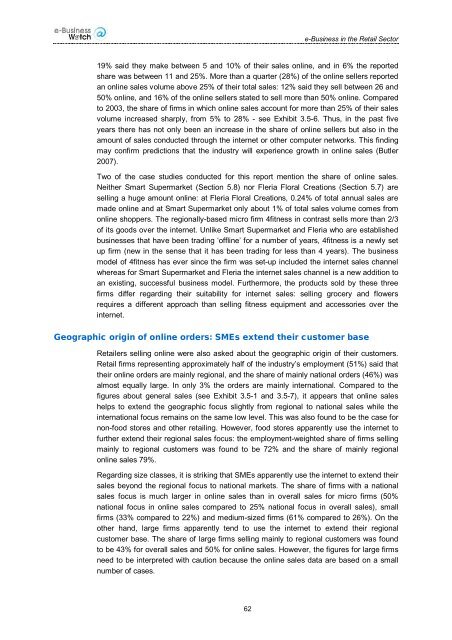ICT and e-Business Impact in the Retail Industry - empirica
ICT and e-Business Impact in the Retail Industry - empirica
ICT and e-Business Impact in the Retail Industry - empirica
- No tags were found...
Create successful ePaper yourself
Turn your PDF publications into a flip-book with our unique Google optimized e-Paper software.
e-<strong>Bus<strong>in</strong>ess</strong> <strong>in</strong> <strong>the</strong> <strong>Retail</strong> Sector19% said <strong>the</strong>y make between 5 <strong>and</strong> 10% of <strong>the</strong>ir sales onl<strong>in</strong>e, <strong>and</strong> <strong>in</strong> 6% <strong>the</strong> reportedshare was between 11 <strong>and</strong> 25%. More than a quarter (28%) of <strong>the</strong> onl<strong>in</strong>e sellers reportedan onl<strong>in</strong>e sales volume above 25% of <strong>the</strong>ir total sales: 12% said <strong>the</strong>y sell between 26 <strong>and</strong>50% onl<strong>in</strong>e, <strong>and</strong> 16% of <strong>the</strong> onl<strong>in</strong>e sellers stated to sell more than 50% onl<strong>in</strong>e. Comparedto 2003, <strong>the</strong> share of firms <strong>in</strong> which onl<strong>in</strong>e sales account for more than 25% of <strong>the</strong>ir salesvolume <strong>in</strong>creased sharply, from 5% to 28% - see Exhibit 3.5-6. Thus, <strong>in</strong> <strong>the</strong> past fiveyears <strong>the</strong>re has not only been an <strong>in</strong>crease <strong>in</strong> <strong>the</strong> share of onl<strong>in</strong>e sellers but also <strong>in</strong> <strong>the</strong>amount of sales conducted through <strong>the</strong> <strong>in</strong>ternet or o<strong>the</strong>r computer networks. This f<strong>in</strong>d<strong>in</strong>gmay confirm predictions that <strong>the</strong> <strong>in</strong>dustry will experience growth <strong>in</strong> onl<strong>in</strong>e sales (Butler2007).Two of <strong>the</strong> case studies conducted for this report mention <strong>the</strong> share of onl<strong>in</strong>e sales.Nei<strong>the</strong>r Smart Supermarket (Section 5.8) nor Fleria Floral Creations (Section 5.7) aresell<strong>in</strong>g a huge amount onl<strong>in</strong>e: at Fleria Floral Creations, 0.24% of total annual sales aremade onl<strong>in</strong>e <strong>and</strong> at Smart Supermarket only about 1% of total sales volume comes fromonl<strong>in</strong>e shoppers. The regionally-based micro firm 4fitness <strong>in</strong> contrast sells more than 2/3of its goods over <strong>the</strong> <strong>in</strong>ternet. Unlike Smart Supermarket <strong>and</strong> Fleria who are establishedbus<strong>in</strong>esses that have been trad<strong>in</strong>g ‘offl<strong>in</strong>e’ for a number of years, 4fitness is a newly setup firm (new <strong>in</strong> <strong>the</strong> sense that it has been trad<strong>in</strong>g for less than 4 years). The bus<strong>in</strong>essmodel of 4fitness has ever s<strong>in</strong>ce <strong>the</strong> firm was set-up <strong>in</strong>cluded <strong>the</strong> <strong>in</strong>ternet sales channelwhereas for Smart Supermarket <strong>and</strong> Fleria <strong>the</strong> <strong>in</strong>ternet sales channel is a new addition toan exist<strong>in</strong>g, successful bus<strong>in</strong>ess model. Fur<strong>the</strong>rmore, <strong>the</strong> products sold by <strong>the</strong>se threefirms differ regard<strong>in</strong>g <strong>the</strong>ir suitability for <strong>in</strong>ternet sales: sell<strong>in</strong>g grocery <strong>and</strong> flowersrequires a different approach than sell<strong>in</strong>g fitness equipment <strong>and</strong> accessories over <strong>the</strong><strong>in</strong>ternet.Geographic orig<strong>in</strong> of onl<strong>in</strong>e orders: SMEs extend <strong>the</strong>ir customer base<strong>Retail</strong>ers sell<strong>in</strong>g onl<strong>in</strong>e were also asked about <strong>the</strong> geographic orig<strong>in</strong> of <strong>the</strong>ir customers.<strong>Retail</strong> firms represent<strong>in</strong>g approximately half of <strong>the</strong> <strong>in</strong>dustry’s employment (51%) said that<strong>the</strong>ir onl<strong>in</strong>e orders are ma<strong>in</strong>ly regional, <strong>and</strong> <strong>the</strong> share of ma<strong>in</strong>ly national orders (46%) wasalmost equally large. In only 3% <strong>the</strong> orders are ma<strong>in</strong>ly <strong>in</strong>ternational. Compared to <strong>the</strong>figures about general sales (see Exhibit 3.5-1 <strong>and</strong> 3.5-7), it appears that onl<strong>in</strong>e saleshelps to extend <strong>the</strong> geographic focus slightly from regional to national sales while <strong>the</strong><strong>in</strong>ternational focus rema<strong>in</strong>s on <strong>the</strong> same low level. This was also found to be <strong>the</strong> case fornon-food stores <strong>and</strong> o<strong>the</strong>r retail<strong>in</strong>g. However, food stores apparently use <strong>the</strong> <strong>in</strong>ternet tofur<strong>the</strong>r extend <strong>the</strong>ir regional sales focus: <strong>the</strong> employment-weighted share of firms sell<strong>in</strong>gma<strong>in</strong>ly to regional customers was found to be 72% <strong>and</strong> <strong>the</strong> share of ma<strong>in</strong>ly regionalonl<strong>in</strong>e sales 79%.Regard<strong>in</strong>g size classes, it is strik<strong>in</strong>g that SMEs apparently use <strong>the</strong> <strong>in</strong>ternet to extend <strong>the</strong>irsales beyond <strong>the</strong> regional focus to national markets. The share of firms with a nationalsales focus is much larger <strong>in</strong> onl<strong>in</strong>e sales than <strong>in</strong> overall sales for micro firms (50%national focus <strong>in</strong> onl<strong>in</strong>e sales compared to 25% national focus <strong>in</strong> overall sales), smallfirms (33% compared to 22%) <strong>and</strong> medium-sized firms (61% compared to 26%). On <strong>the</strong>o<strong>the</strong>r h<strong>and</strong>, large firms apparently tend to use <strong>the</strong> <strong>in</strong>ternet to extend <strong>the</strong>ir regionalcustomer base. The share of large firms sell<strong>in</strong>g ma<strong>in</strong>ly to regional customers was foundto be 43% for overall sales <strong>and</strong> 50% for onl<strong>in</strong>e sales. However, <strong>the</strong> figures for large firmsneed to be <strong>in</strong>terpreted with caution because <strong>the</strong> onl<strong>in</strong>e sales data are based on a smallnumber of cases.62
















